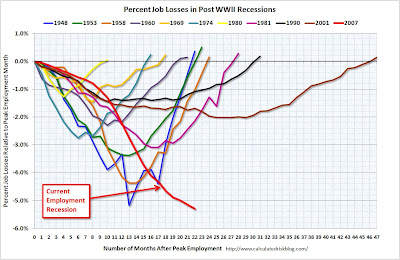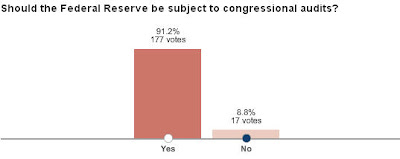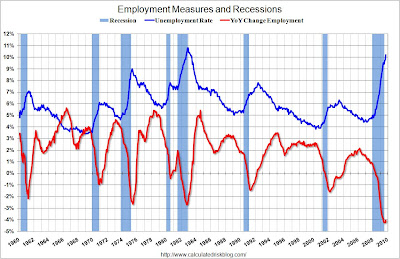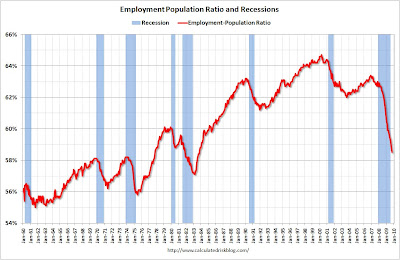Home » US (Page 2)
Category Archives: US
What gold price is telling us
Looking at gold future price, I have become more worried about the US dollar lately. Are we going to have 1971-collapse of US dollar again? The sharp drop of US dollar and China potentially losing a huge chunk of its foreign reserve value remain to be the biggest risk in the system.
Guess I need to be more imaginative in this wildly uncertain world.
(click to enlarge)
Obama’s town hall meeting in China
China and the US: adversaries or friends?
Unfortunately, Obama’s speech was censored in China.
John Ryding: Unemployment to peak out in 4-5 months
Interview of John Ryding, Chief Economist of RDQ Economics. He painted a more optimistic picture of US unemployment outlook. For the economy to create jobs, weekly initial jobless claims need to come down to 400k range from the current 500k. The recent decline is 5,000 claims per week, so it will take 20 weeks to reach 400k level. Then unemployment rate will come down.
The question is how fast the job creation will be. It’ll be a big problem for the US economy if 9-10% unemployment rate stays there for a long time.
Higher productivity at the expense of labor
Labor productivity grew 9.5% last quarter. This growth came at the expense of laying off workers massively, and squeezing the current workers who still have their jobs. You can complain but you dare not jump ships as the labor market is still very soft.
High productivity growth is typical at the end of recession and at the beginning of recovery. But because firms cut employees more quickly and aggressively during this recession, current workers feel especially squeezed.
The productivity of U.S. workers surged in the third quarter, as the economy resumed growing even as employers pushed forward with layoffs and cuts in working hours across a wide range of industries.
The Labor Department said the output per hour of nonfarm workers rose at an annual rate of 9.5% in the quarter, more than four times the average productivity growth rate of the past quarter-century. When taken together with the second quarter’s 6.9% rise, it was the strongest productivity growth rate over a six-month period since 1961.
(click to enlarge)
The source of the productivity boom is straightforward. Firms are continuing to cut costs even as the economy heals, meaning they are getting more from existing work forces. Nonfarm output rose at a 4% annual rate in the third quarter while hours worked decreased at a 5% annual rate, the department said.
While unemployment remains high, corporate profits have bounced back from the shock of 2008. If output keeps climbing, employment should follow — and reduce productivity growth from the third quarter’s rate.
Big productivity gains are common at the end of recessions and the beginning of recoveries. The usual pattern is productivity grows first, then employment rises, and finally wages increase.
The productivity gains should prevent an outbreak of inflation even though the Federal Reserve has held short-term interest rates near zero and pumped $1 trillion into the financial system through loans and securities purchases. In normal times, so much monetary stimulus would push consumer prices much higher.
The Labor Department reported that unit labor costs — a measure of what it costs firms to pay workers for a single unit of output they produce — fell at a 5.2% annual rate in the quarter. They are down 3.6% from a year ago, the steepest drop since the Labor Department began keeping records in 1945.
“The combination of rapidly increasing productivity and falling unit labor costs puts downward pressure on inflation, and should make the Fed more comfortable about pursuing accommodative monetary policy amidst economic growth,” J.P. Morgan economists said in a note to clients.
The productivity of workers is a linchpin to an economy’s health and growth potential. The U.S. economy went through a productivity drought in the 1970s and ’80s and a resurgence in the late ’90s. It slowed sharply between 2004 and 2008.
Though the latest jump could be the start of a new upturn, there are reasons to doubt that the latest rebound can be sustained. The financial shock of 2008 could debilitate a key part of the economy — the financial sector. The regulatory reshuffling that the crisis has produced could also sap the productivity of some industries. Moreover, business investment has fallen sharply, which has held back a key driver of productivity growth in the past — business use of new technologies.
Some analysts said businesses might start investing more now. “Faster productivity growth will support profits, and could lead to a more vigorous rebound in capital spending than envisaged,” Jared Franz, an analyst at T.Rowe Price, said in a commentary on the report.
A separate report by the Labor Department suggested that the intensity of layoffs could be waning. The department said new claims for unemployment benefits decreased by 20,000 to 512,000 in the week ended Oct. 31. That is the lowest level since Jan. 3. The previous week’s level was revised to 532,000. These are still high levels but appear to be on a downtrend.
The four-week moving average of new claims, which aims to smooth volatility in the data, fell by 3,000 to 523,750 from the previous week’s revised figure of 526,750. That is the lowest level since Jan. 10.
The U.S. employment report for October, out on Friday, is expected to show that the jobless rate stayed close to a 26-year high of 9.8% in September.
US labor market update
October unemployment rate jumped to 10.2%, an important psychological threshold. The decline of employment has slowed down, but the unemployment rate will continue to rise, albeit more slowly.
Employment-population ratio dropped to the lowest level since 1983.
Compared to previous recessions, it looks like we are going to enter a “mother of all jobless recoveries” in this recession.

(graphs courtesy of calculatedrisk, as usual)
In terms of prolonged unemployment, we reached the highest level on record.
(graph courtesy of bigpicture, click to enlarge)
Now listen to Goldman Sachs’ Jan Hatzius on the US job market outlook:
Dollar perspective and complications
Interview of Nail Ferguson at Harvard: China’s peg to the US dollar makes other export countries’ export more expensive, adding pressure to currency intervention of those countries to support the dollar.
China’s fixing its currency to the dollar also increases speculative activities across borders, leading the one-way bet that China’s Yuan will appreciate in the future.
The first raises chances of trade protectionism; the second increases chance of an overheating Chinese domestic economy (although China has capital control, we know investors can always find their money into China).
But Chinese policy makers won’t allow Yuan to appreciate because it will hurt its export sector and China’s slow adjustment toward domestic consumption will take a while, longer than most thought.




![Reblog this post [with Zemanta]](https://img.zemanta.com/reblog_e.png?x-id=bbf0d872-6e52-4d75-ac57-6be3c9e278cb)

![Reblog this post [with Zemanta]](https://img.zemanta.com/reblog_e.png?x-id=b3f5dcf3-9c61-4a38-aef3-c8b15885accc)


![Reblog this post [with Zemanta]](https://img.zemanta.com/reblog_e.png?x-id=1ef014db-7b2c-4e8f-be45-04157376c1f1)


![Reblog this post [with Zemanta]](https://img.zemanta.com/reblog_e.png?x-id=a708a41b-3d07-4d50-abd5-226d66012144)
![Reblog this post [with Zemanta]](https://img.zemanta.com/reblog_e.png?x-id=b4e45092-1768-4f19-a3f2-64836f5d29e0)